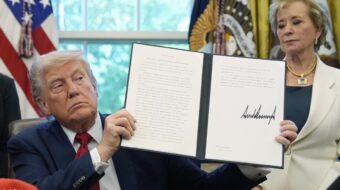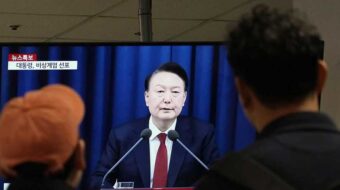The American people are not a ‘focus group’
On Feb. 15-16 a new peace movement was born. A movement that represents the people’s heartfelt concerns that international problems be resolved peacefully, instead of what the Bush administration has pushed – a war on Iraq.
Grandparents went into the streets with their children and grandchildren to join hospital and longshore workers, movie stars, elected officials, teachers, college students, ministers, rabbis and imams to say, “The world says no to war.”
People came out who never demonstrated before. Millions marched here and around the world. Over a million Americans, in New York, San Francisco and many other cities and towns, marched, rallied and held signs calling for peace. The latest polls show the overwhelming majority of people in the U.S. want more time for the UN weapons inspections, and do not want unilateral action.
Yet George W. Bush does not see this movement for what it is – democracy in action. Bush dismissed the protests this weekend, saying deciding policy based on the protests would be like using a “focus group.” He then continued to bully the UN and countries that disagree with war as a first solution.
But indeed, Bush has determined his policy on Iraq with a “focus group” – a small, elite grouping of the oil industry, military contractors and far right ideologues inside and outside of elected government. This far right “focus group” seeks a U.S. foreign policy based on first strike use of nuclear weapons, regime change and foreign aid loan sharking to control the world for free market capitalism.
This is a turning point moment and a movement has grown, which can actually stop this war drive. But now we in the U.S. have a special responsibility to take the struggle into the halls of Congress in order to stop this war. Congress must act and represent the American people by fighting to let UN inspections work and for a peaceful, diplomatic solution.
No nukes!
The Bush administration is suffering from a severe case of nuclear weapons creep – moving slowly but steadily toward a pre-emptive strike policy using nuclear weapons, with Iraq the first test.
The most recent manifestation of the disease came on Jan. 10 when 32 weapons managers from nuclear weapons laboratories and representatives of the military and the Department of Defense attended a meeting where they discussed the future of the U.S. nuclear weapons program. The meeting was “outed” last week. Among other things, they laid plans for a secret meeting at the Omaha, Neb., headquarters of the Strategic Air Command to discuss what new nuclear weapons to build and how to test them.
Although the U.S. has never agreed to a “no first strike” pledge on the use of nuclear arms, it has promised not to use them against countries that do not have them. But that is changing and, as The Los Angeles Times reports, the Pentagon is looking at how nuclear weapons might be used in the event of war.
Much of the “justification” for the use of nuclear weapons lies in the argument that they are no different from conventional weapons and need not be governed by separate rules. The administration is seeking to blur the decades-old distinction between nuclear and conventional weapons, a distinction that has, for nearly 60 years, prevented the use of nuclear arms.
But they are different – they are not just one more rung on a ladder from stones to clubs, from gunpowder to “smart” bombs. Their ability to instantly wipe out thousands of lives and entire cities and kill millions over time with toxic radiation makes them qualitatively different.
Plans to develop and test new nuclear weapons are a clear violation of the 1954 Comprehensive Test Ban and Nuclear Nonproliferation treaties.
While it is true that the U.S. anti-war movement has a full plate, it must find room for this issue, otherwise the U.S. will surely be a nuclear “rogue state.”









